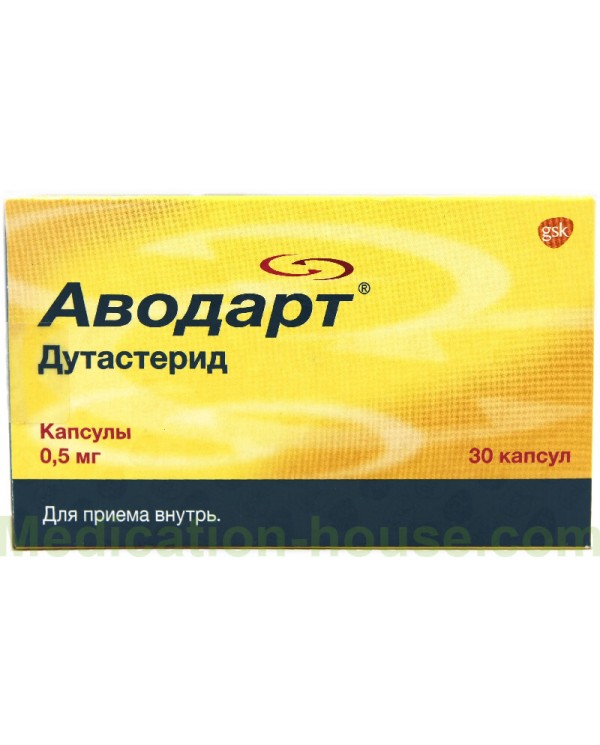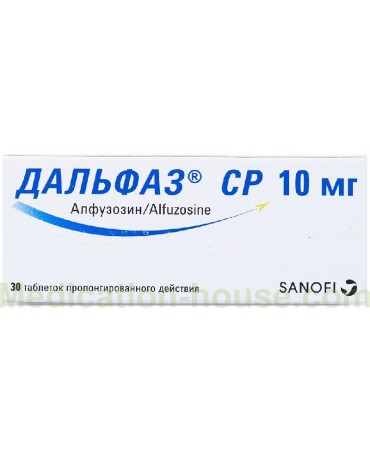Avodart instruction
You can buy Avodart here
Avodart is a drug intended for the treatment of benign prostatic hyperplasia.
Release form and composition
Avodart is produced in the form of soft yellow oblong capsules marked "GX CE2", which contain 0.5 mg of dutasteride and auxiliary components: caprylic acid monodiglycerides and butylhydroxytoluene. In blisters of 10 capsules, 3 or 9 blisters in a cardboard box.
Pharmacodynamics
Dutasteride is a dual 5-alpha reductase inhibitor that inhibits the activity of type 1 and type 2 5-alpha reductase isoforms responsible for converting testosterone to the more potent androgen, dihydrotestosterone (DHT). This biologically active form of testosterone affects the hyperplasia of the glandular tissues of the prostate gland.
The maximum effect of dutasteride on lowering the DHT content is observed 7-14 days after the start of therapy. This process is dose dependent. After 1 week of taking dutasteride at a dose of 0.5 mg per day, the average concentration of the substance in the blood serum decreases by 85%, after 2 weeks - by 90%.
Pharmacokinetics
absorption: after a single dose of dutasteride in a dose of 0.5 mg, the time to reach the maximum content of the substance in the blood serum is 1-3 hours. In men, the absolute bioavailability of dutasteride is approximately 60% relative to a two-hour intravenous infusion. Food intake does not affect bioavailability;
distribution: obtained with multiple and single doses of dutasteride, pharmacokinetic data show that the volume of its distribution is 300-500 liters. More than 99.5% of dutasteride binds to plasma proteins. In the case of daily intake, the concentration of the substance in the blood serum after 1 month is approximately 65% of the stable level, after 3 months - about 90%. With a single daily intake of 0.5 mg of Avodart, stable concentrations of dutasteride (Css) in serum at a level of 40 ng / ml are achieved after 6 months. A similar period is typical for achieving stable concentrations of dutasteride in semen. After 52 weeks of therapy, the mean semen concentration of dutasteride was about 3.4 ng / ml (0.4-14 ng / ml). About 11.5% of the substance gets into the semen from the blood serum;
metabolism: dutasteride in vitro is metabolized by the CYP3A4 isoenzyme of the human cytochrome P450 family with the formation of 2 small monohydroxylated metabolites. Isoenzymes CYP2A6, CYP1A2, CYP2C8, CYP2E1, CYP2C19, CYP2C9, CYP2D6, CYP2B6 of this system do not act on dutasteride. In the course of studies by the mass spectrometric method, unchanged dutasteride, 2 small metabolites (15-hydroxydutasteride and 6,4'-dihydroxydutasteride) and 3 large metabolites (1,2-dihydroductasteride, 4'-hydroxydutasteride, 6-hydroxydutasteride);
excretion: dutasteride in the human body undergoes intensive metabolism. After oral administration of dutasteride at a dose of 0.5 mg per day to achieve a stable concentration, an average of about 5.4% of the dose taken (1-15.4%) is excreted unchanged through the intestines. The rest is excreted through the intestine in the form of 6 small metabolites (less than 5% for each share) and 4 large metabolites (the shares of which, respectively, are 7%, 7%, 21% and 39%). In humans, traces of dutasteride (up to 0.1% of the dose) are excreted unchanged through the kidneys. The terminal half-life of dutasteride in the case of taking therapeutic doses is 3 to 5 weeks. In 4–6 months after discontinuation of Avodart's administration, 0.1 ng / ml of dutasteride is detected in the blood serum.
The pharmacokinetics of dutasteride are described as a first-order absorption process, as well as parallel saturable (concentration-dependent) and unsaturated (concentration-independent) elimination processes. In the case of low serum concentrations (up to 3 ng / ml), the substance is rapidly excreted by both elimination processes. As a result of a single dose of 5 mg (or less) of dutasteride, it is rapidly excreted from the body (half-life is from 3 to 9 days).
At a serum concentration of more than 3 ng / ml of dutasteride, the elimination rate is from 0.35 to 0.58 l / h, mainly by a linear unsaturated elimination process (the final half-life is from 3 to 5 weeks).
The final half-life at therapeutic concentrations ranges from 3 to 5 weeks, and while taking Avodart at a dose of 0.5 mg per day, a slower clearance of dutasteride prevails. The total clearance is independent of concentration and is linear. For 4-6 months after stopping dutasteride intake, more than 0.1 ng / ml of the active substance is detected in the blood serum.
The pharmacokinetics and pharmacodynamics of dutasteride were studied using 36 healthy male volunteers aged 24–87 years after a single dose of 5 mg dutasteride. During the study, no statistically significant differences in the main pharmacokinetic parameters (maximum plasma concentration and area under the concentration-time curve) were found between different age groups. There were no statistically significant differences in the half-life of dutasteride between the age groups of healthy volunteers from 50 to 69 years old and over 70 years old (this age interval includes the majority of patients suffering from benign prostatic hyperplasia).
In different age groups, there were no significant differences in the degree of decrease in dihydrotestosterone levels. These results indicate that there is no need to reduce the dose of dutasteride in elderly patients.
Indications for use
According to the instructions, Avodart is intended for the treatment and prevention of benign prostatic hyperplasia.
Contraindications
Avodart is contraindicated:
Women and children;
With hypersensitivity to the components of Avodart and to other medicines related to 5α-reductase inhibitors.
Since dutasteride is extensively metabolized in the liver, caution is needed when using Avodart in patients with impaired liver function.
Instructions for use: method and dosage
Avodart can be prescribed in combination with tamsulosin, or as monotherapy. The drug is taken regardless of food intake. Although the positive effect of treatment can come fairly quickly, it should be continued for at least 6 months.
For adult men, according to the instructions for Avodart, the recommended dose is 0.5 mg (1 capsule) per day. To avoid possible irritation of the mucous membrane of the mouth and pharynx, the capsule is swallowed whole, without chewing or opening. The dosage of the drug for elderly men and patients with impaired renal function is similar to the dosage for adult men and does not require correction.
Side effects
According to clinical studies, the use of the drug as a monotherapy agent can have a number of negative consequences, manifested as:
Decreased libido
Impotence,
Ejaculation disorders
Gynecomastia (breast enlargement and tenderness).
With combined therapy with Avodart and tamsulosin, in addition to the likelihood of the same side effects as with monotherapy, dizziness is possible.
Observations in clinical practice make it possible to distinguish such reactions of the body to Avodart as itching, rash, urticaria, angioedema, and limited edema.
Overdose
With a single dose of up to 40 mg / day of dutasteride for 7 days (80 times the therapeutic dose), significant side effects were not recorded.
In the course of clinical studies, patients were prescribed dutasteride at a dose of 5 mg daily for 6 months. In this case, no additional side effects were observed other than those with 0.5 mg of dutasteride. There is no specific antidote, therefore, symptomatic and supportive therapy is recommended in case of an overdose of Avodart.
Special instructions
Women and children should avoid contact with damaged capsules of the drug, since the active component of the drug can be absorbed through the skin. In case of contact with dutasteride, the affected area of the skin should be washed with soap and water.
Application during pregnancy and lactation
Women are prohibited from using the drug. Special studies on this matter have not been carried out, however, according to preclinical data, suppression of the level of dihydrotestosterone can inhibit the development of the external genital organs in a male fetus.
There are no data on the excretion of dutasteride in breast milk.
Childhood use
It is forbidden to use Avodart to treat children.
With impaired renal function
In case of impaired renal function, dose adjustment is not required.
For violations of liver function
If liver function is impaired, Avodart should be used with caution.
Use in the elderly
When treating elderly patients, dose adjustment is not required.
Drug interactions
In vitro, the isoenzyme CYP3A4 of the human cytochrome P450 system is responsible for the metabolism of dutasteride, therefore, in the presence of CYP3A4 inhibitors, the concentration of dutasteride in the blood may increase.
In the case of the simultaneous use of CYP3A4 inhibitors diltiazem and verapamil with dutasteride, there is a decrease in the clearance of the latter. At the same time, the combined use of calcium channel blockers (for example, amlodipine) with dutasteride does not reduce the clearance of the latter. A decrease in the clearance of dutasteride when using CYP3A4 inhibitors with a subsequent increase in its content in the blood is not of clinical significance, since dutasteride has a wide range of safety margins. That is why there is no need to adjust its dose.
The following isoenzymes of the human cytochrome P450 system do not affect the metabolism of dutasteride in vitro: CYP2A6, CYP1A2, CYP2C8, CYP2E1, CYP2C19, CYP2C9, CYP2D6, CYP2B6. In vitro, dutasteride does not inhibit the enzymes of the human cytochrome P450 system, which are responsible for the metabolism of drugs.
Dutasteride in vitro does not displace acenocoumarol, warfarin, diazepam, phenytoin and phenprocoumon from the sites of binding of these drugs to plasma proteins. In turn, these drugs do not supplant dutasteride.
In the course of human studies of the processes of interaction of dutasteride with terazosin, tamsulosin, digoxin, cholestyramine and warfarin, no clinically significant pharmacodynamic and pharmacokinetic interactions were found.
With the simultaneous use of dutasteride and lipid-lowering drugs, beta-blockers, ACE inhibitors, calcium channel blockers, diuretics, corticosteroids, type V phosphodiesterase inhibitors, nonsteroidal anti-inflammatory drugs, quinolone antibiotics, no significant unwanted drug interactions were recorded.
Terms and conditions of storage
Shelf life is 4 years.
Store at a temperature not exceeding 30 ° C out of the reach of children.
Reviews
Reviews about Avodart are ambiguous. So, some patients report that after taking the drug for a year, the prostate gland shrank, but when therapy was stopped, its size again slightly increased.
As a disadvantage of the tool, many users cite the high cost. Also, some reviews contain information that in the first months of taking Avodart, erectile dysfunction and a decrease in libido can be observed (this effect usually disappears after 3-4 months of therapy). Information about the occurrence of adverse reactions is quite rare, there are data on individual cases of hair loss and acute drug intolerance.
Terms of sell
You can buy Avodart without a prescription from a doctor.


